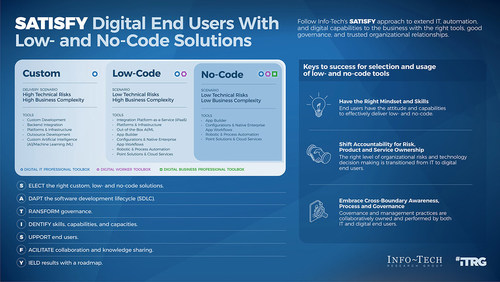Global IT research and advisory firm Info-Tech Research Group has published its newest research-backed blueprint, titled Satisfy Digital End Users With Low- and No-Code. IT departments are increasingly experiencing capacity constraints due to the current talent shortage and the overwhelming demand to meet business priorities while maintaining mission-critical applications. This timely research will help IT teams leverage low- and no-code solutions to solve their software delivery challenges and explore new digital capabilities.

Low- and no-code (LCNC) application builders leverage graphical user interfaces (GUI) and configurations to define and build databases, business logic, process flows, forms, and other application artifacts with minimal hand-coding. These tools convert the developer’s designs into workable software that can then be deployed to corporate systems.
Latest ITechnology News: Cloudways Demonstrates Growth Ambitions with Customer Momentum, New Features, and Key Executive Hires
Low-code technologies, alongside customizable scripts and configurations, assist GUI designers in defining and building applications. Similar to low-code, no-code technologies create deployable and functioning solutions to develop applications primarily for people who are not familiar with coding.
However, without the right training, adoption plan, and governance structure for LCNC, IT can become quickly overwhelmed with product quality, management challenges, and maintenance. Info-Tech advises organizations must work with IT for LCNC to succeed.
“Low- and no-code empowers users to tailor the tools they need to be more productive and innovative,” says Info-Tech’s Senior Research Analyst Andrew Kum-Seun. “This capability also encourages the business and IT to build trust, respect, and accountability with each other by working more closely together.”
Latest ITechnology News: Acumera Expands Services and Market Reach by Acquiring Netsurion’s Secure Edge Networking
Although LCNC has been around for years, it has recently become a popular choice among organizations. For example, Info-Tech’s 2022 Tech Trends Report revealed that 69% of IT practitioners had digital transformation as a high priority for their organization during the pandemic. Additionally, according to a 2021 TechRepublic survey, 47% of respondents indicated that their organizations use LCNC platforms, which provide numerous benefits and help with transformation by easing the implementation of key initiatives. Info-Tech’s blueprint breaks down why LCNC is an attractive option for organizations, outlined below:
- Extendable & Scalable: LCNC solutions are extendable and adaptable with out-of-the-box connectors and/or representational state transfer API. The plug-and-play architecture allows non-technical staff to bridge LCNC to third-party systems and explore new use cases.
- Seamless Deployment: Most LCNC vendors offer one-click deployment to their proprietary platform as well as cloud services such as PaaS, IaaS, or direct publishing to app stores. Built-in automated tests ensure compatibility with the target environment.
- Extensive LCNC Use Cases: The LCNC marketplace is extensive and offers a broad range of use cases. 17% of organizations are planning on using LCNC to automate workflows, 15% to create new apps, and 15% plan to use it to speed up development time.
- Operational Change Acceptance: Stakeholders realize that fighting shadow IT is a losing battle, so they are finding ways to embrace it. They also recognize that IT operations and organizational culture must change to see the full benefits of LCNC in a business-managed environment. LCNC is a notable option given its centralized administration capabilities and compatibility with existing systems.
- Hands-Off Operational Support: Many LCNC solutions operate in an as-a-service model where the underlying and integrated technologies are managed by the vendor and abstracted away from the end user. AI and machine learning are often used to reconfigure or load balance the system as needed.
LCNC is the perfect solution to remove the stress that comes from traditional software development. Only a single codebase is needed to create solutions across different form factors, minimizing the need for platform-specific expertise and toolsets.
Latest ITechnology News: SAS a Leader in Real-Time Interaction Management per Independent Research Firm Report
[To share your insights with us, please write to sghosh@martechseries.com]


